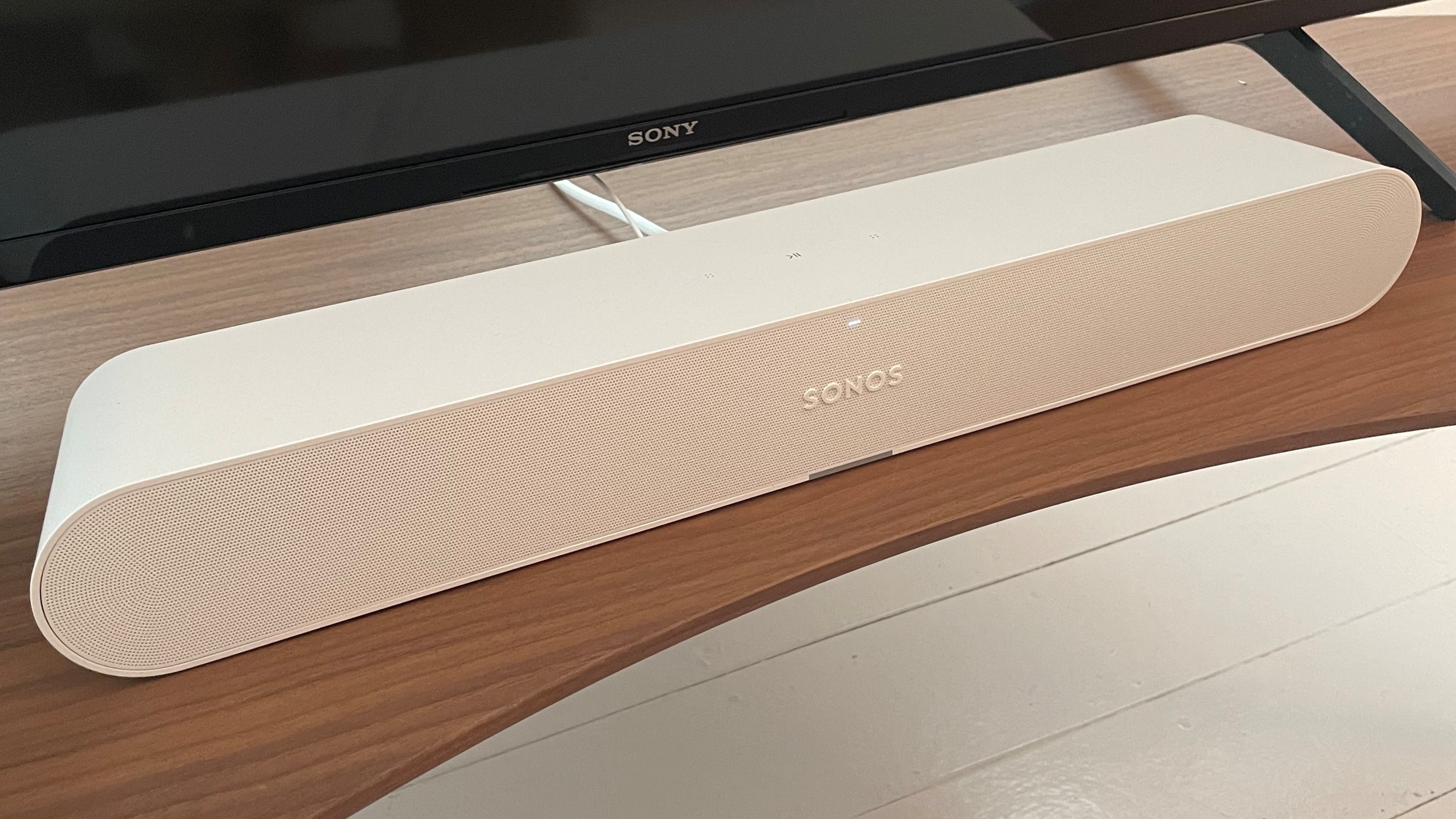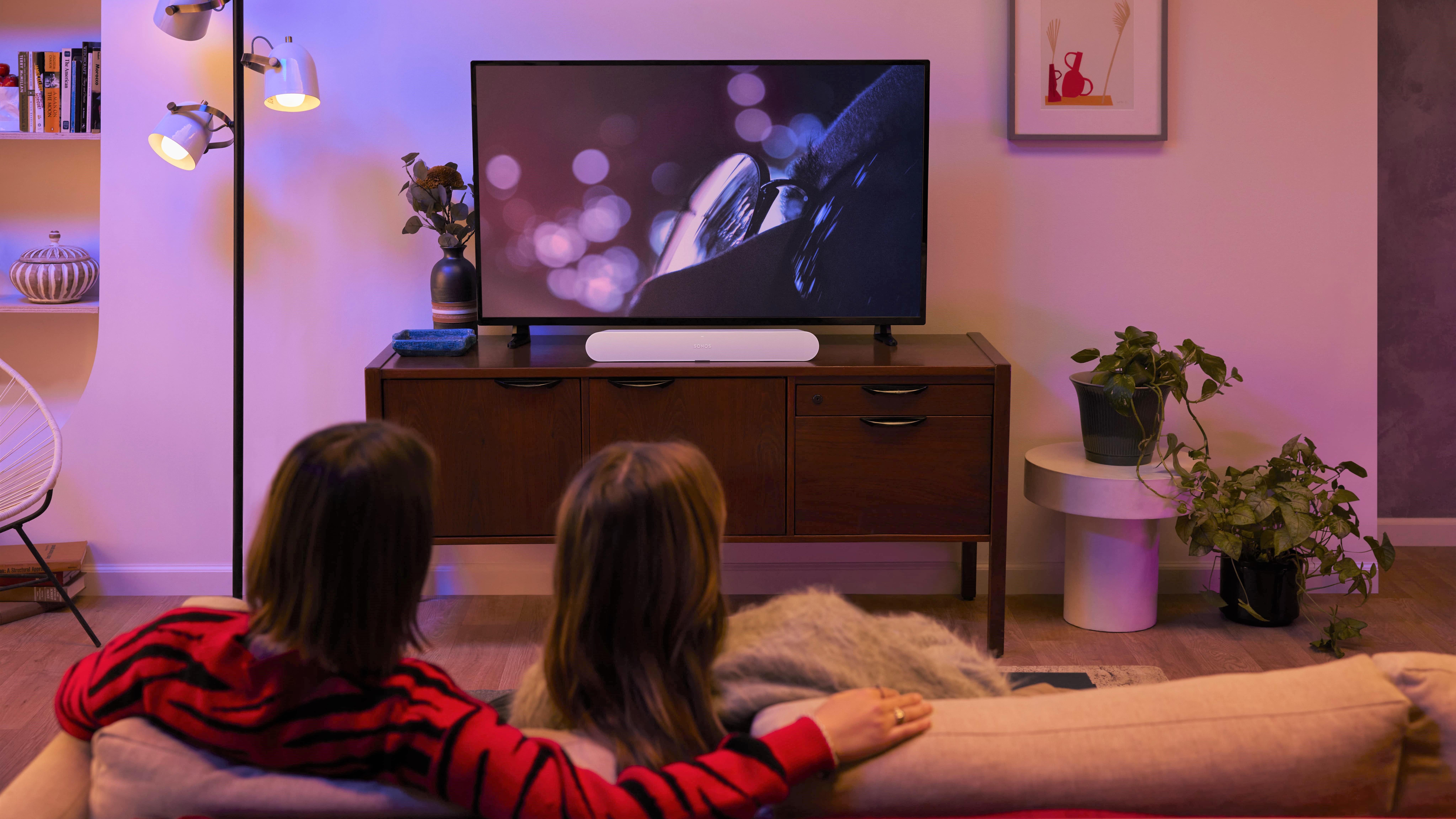I just tried the Sonos Ray soundbar — and I was blown away by the results

Sonos has introduced its most affordable soundbar to date in the form of the $279 Sonos Ray — available to pre order now for stock that’s expected to arrive later this month.
Our full Sonos Ray review has a full breakdown of the pros and cons and all the specs, but I wanted to find out for myself how good this soundbar really is. Fortunately, I got an invite to experience the new Sonos Ray soundbar ahead of the official launch, but I wasn't quite prepared for how diminutive the new soundbar speaker was when I first saw it perched in front of a TV screen in the Sonos demo room.
Of course, I understand the expertise with which Sonos is able to make small speakers deliver bigger sound than you would traditionally expect — with the likes of the Sonos Roam and Sonos One compact speaker designs aimed at music listening. But I confess, seeing it in the flesh for the first time, I had some doubts about whether the Ray soundbar could deliver the kind of impact I expect to hear when watching best Netflix shows or best movies on Amazon Prime Video.
Sonos Ray: Tuned by experts

I'm well practiced at keeping an open mind during audio demos, whether they be for luxury hi-fi speakers, multi-channel surround sound or soundbars. But as I took my seat on the sofa at the press briefing in a room that was for all intents and purposes furnished to replicate a small-to-medium-sized TV room, I did wonder what sort of sound I was about to experience. In fact, I don't think I'd ever been to an audio demo to hear such a compact speaker before...
I was mightily impressed by the balanced audio the slender TV speaker produced in front of me, pushing out a far bigger sound than I was anticipating.
Of course, I needn't have doubted it for a second, and once Sonos's experience manager had finished talking me through the design configuration and tech incorporated inside the Sonos Ray, I sat back and got the chance to listen to it for the first time. The sound demo included excerpts from movies including Venom and No Time to Die (both are packed with high-octane action effects), and I was mightily impressed by the balanced audio the slender TV speaker produced in front of me, pushing out a far bigger sound than I was anticipating.
Dialog can often be the most tricky range of frequencies for many compact speakers to accurately replicate, as mid frequencies in the vocal range rely on mid-woofers that very often aren't large enough to achieve the kind of frequency extension to bring sufficient weight to voices, particularly where male voice are concerned that require a bit more gravitas to make them sound convincing. Nevertheless (and despite the smallish speakers built into the cabinet), there was no feeling of being shortchanged.
The Sonos Ray delivered the powerful dialog between Tom Hardy's character Eddie Brock and his alien psyche in Venom: Let There Be Carnage with an impressive amount of depth to give the voices conviction, and despite there being just left and right speakers (a tweeter and mid-woofer each side), vocals steered and panned perfectly in sync with the images on the screen.
Get instant access to breaking news, the hottest reviews, great deals and helpful tips.
Moving on to the next demo sequence and the latest Bond movie, No Time To Die, where the car windows are being shot at with the inhabitants barely flinching inside, this was impressively powerful despite the fact that Sonos Ray uses just two mid-woofer speaker drivers inside a comparatively small bass reflex ported cabinet.
Sonos Ray: The home sound test

The Sonos Ray delivered plenty of punch at home, and I could place the speaker on the same shelf as the TV without blocking the bottom of the screen
Listening to the Sonos Ray at home connected to my own TV via the supplied optical digital audio cable (there's no HDMI port), proved to be just as rewarding. Sometimes products don't quite live up to the memory of a professional demo once you get them home, but in the case of the Sonos Ray soundbar, it sounded almost as good straight from the packing crate as I'd heard at the Sonos event. In fact, its factory sound was better than many larger soundbars I've unboxed recently, which is impressive indeed.
Despite being a larger room and a different layout arrangement to the way I heard the soundbar at the demo, the Sonos Ray delivered plenty of punch at home and I could place the speaker on the same shelf as the TV without blocking the bottom of the screen. Even without going through the Trueplay setup to optimize the sound for my particular space through the Sonos app on my iPhone, the sound delivery proved to be a major step up on my TV's own speakers.
Activating the Trueplay mode (once you've been through the room calibration process), did achieve a slightly wider soundstage, but it sounded a bit too unnatural and otherworldly in a fake 'pseudo surround' way for my ears. So I have been listening to it with Trueplay off and made just a few subtle tweaks to the EQ to optimize the sound to my own tastes and ears.
Sonos Ray: Stereo is best
I think one of the reasons I enjoy the sound from the Sonos Ray soundbar so much, is because ultimately it's just a stereo speaker with tweeter and mid-woofer speakers placed either side in a simple bass reflex cabinet — this is a standard loudspeaker arrangement that's been successful for hi-fi speaker designers for years. The Sonos Ray handles Dolby Digital 5.1 and DTS surround formats of course, but there's no sophisticated DSP (digital signal processing) to turn multi-channel audio signals into surround sound, and soundtracks are simply down sampled by the Sonos to 2.0 channels (stereo sound).
There are no fancy speaker drivers pointing in different directions to help create the illusion of surround sound by reflecting sounds off the side walls, or upward-firing drivers to give a greater impression of height for flyovers on Dolby Atmos supported soundtracks. The four speakers fire forwards from the front of the cabinet, and that's it.
The result is an integrated sound across the Sonos Ray's frequency range. Best of all, it sounds convincing with whatever TV sound (movies, TV dramas, news etc.) you put through it. To me, this makes the Sonos Ray a far more compelling soundbar option than models costing two or three times the price that offer sophisticated tricks to tickle your ears, and fool you into thinking sounds are moving all around you.
If it's a simple upgrade to your TV's built-in speakers you're after, the Sonos Ray looks set to be a very worthy consideration — and if you've already bought in to the company's eco system with Sonos models already dotted around the house then it really is a no-brainer. The Sonos Ray may not have much in the way of frills, but from what I've experienced living with it at home for the past week or so, I'd say it's one of the most attractive and reasonably priced upgrades you can bring to your TV sound right now.
For the latest offers from Sonos, head to our Sonos promo codes page.
Next: I just tried the Sonos Ray soundbar with the new Sonos Sub Mini — check out the full Sonos Sub Mini review and get more bass from your home theater setup.

Lee was Tom's Guide's audio editor, where he covered all things audio for Tom's Guide, including headphones, wireless speakers and soundbars and loves to connect and share the mindfulness benefits that listening to music in the very best quality can bring. As a former editor of the U.K.'s Hi-Fi Choice magazine, Lee is passionate about all kinds of audio tech and has been providing sound advice to enable consumers to make informed buying decisions since he joined Which? magazine as a product tester in the 1990s. Lee has joined the passionate audio experts at audiograde.uk where he writes about luxury audio and Hi-Fi.
